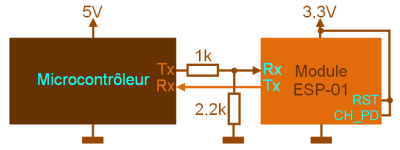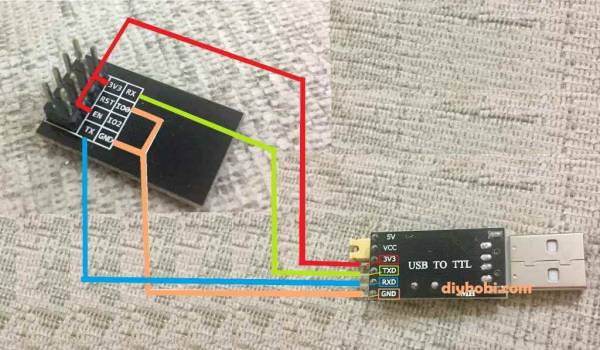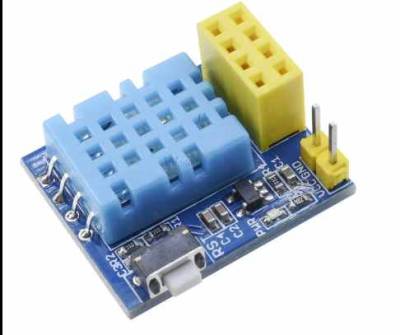Ceci est une ancienne révision du document !
Table des matières
ESP 01 Introduction
L'ESP-01 est l'une des plus petites unités disponibles. Par rapport aux autres unités ESP, il est alimenté directement et doit donc être alimenté en 3,3 V et non en 5 V. Deux GPIO généraux sont disponibles et si vous avez besoin de plus, vous pouvez utiliser les deux ports série (1,3 / RX,TX).
Matériel
- Version de puce ESP : ESP8266
- Taille du flash : 1M
- Convertisseur USB-TTL intégré : Non
- GPIO éclaté/disponible pour une utilisation gratuite : 0, 2
- Informations sur l'alimentation : 3,3 VDC
- Antenne : antenne PCB intégrée
ESP-01 avec un microcontrôleur fonctionnant en 5V
Câblage/clignotement
Un programmeur est nécessaire pour flasher cet appareil.
'Programmateur''ESP'- TX ←→ RX
- RX ←→ TX
'Pouvoir'- 3.3V ←→ VDD
- Terre ←→ Terre
Afin d'obtenir l'unité en mode flash, le GPIO-0 doit être BAS et le CH-EN doit être réglé sur haut. Le CH-EN peut être connecté au VDD, sur les photos un cavalier est soudé entre ceux-ci mais vous pouvez 'utiliser une résistance pour vous assurer qu'aucune surintensité ne blesse l'unité'. Commencez à clignoter et effectuez une réinitialisation une fois afin de lancer le spectacle.
Les unités avec une puce mémoire étiquetée ' PUYA ' doivent être flashées avec les fichiers bin PUYA spécialement construits. Ceci est nécessaire car la puce PUYA doit être traitée d'une autre manière que les puces mem normales.
ESP-01 v3
Certains utilisateurs ont signalé que la réinitialisation ne fonctionnait pas sur les versions ultérieures de l'ESP-01. Il y a une résistance supplémentaire de 6k dans la ligne de réinitialisation (la nécessité de cette résistance est inconnue) entre EXT_RSTB et la broche RST du connecteur 8 broches. Après avoir retiré et remis un cavalier à sa place, la fonction RESET fonctionne à nouveau correctement. Donc, essentiellement, vous pontez simplement la résistance, ce qui en fait une ligne droite.
Flashage ESP01
Racordement pour flashage d'un ESP01
ESP01 et DTH11
Une video pour expliquer
Ou trouver ce module tout cablé
Code pour esp01 et capteur temperature DHT11 via serveur Web (simplifié)
- esp01Tempe001.ino
/* Objet : Serveur web temperature et humidité avec un esp8266-01 Nom : phmo_temp_hum_esp_dht_1.ino Infos sketch : - Créé le 12 jan 2016 sur la base des exemples des bibliotheques Arduino par PHMO */ // ajout des bibs ESP8266 WiFi et sonde dht #include <ESP8266WiFi.h> #include "DHT.h" // la sonde est de type dht22 //#define DHTTYPE DHT22 // la sonde est de type dht11 #define DHTTYPE DHT11 // la sonde dht est connectee sur le port GPIO2 de l esp8266-01 const int DHTPIN=2; // remplacer par le nom et mot de passe de votre reseau wifi const char* ssid = "votre nom wifi"; const char* password = "votre mot de passe wifi"; // definition d'un serveur web ecoutant sur le port 80 WiFiServer server(80); // instanciation objet dht DHT dht(DHTPIN, DHTTYPE); // Instanciation objet dht // variables de travail static char celsiusTemp[7]; static char humidityTemp[7]; // traitements init void setup() { // init liaison serie Serial.begin(115200); delay(10); // init catpeur dht dht.begin(); // connexion au wifi Serial.println(); Serial.print("lancement connexion au reseau wifi : "); Serial.println(ssid); WiFi.begin(ssid, password); while (WiFi.status() != WL_CONNECTED) { delay(500); Serial.print("."); } Serial.println(""); Serial.println("connexion au WiFi OK"); // demarrage serveur web server.begin(); Serial.println("le serveur web est lancé, attente fourniture ip locale de l esp ..."); delay(10000); // affichage adresse ip locale Serial.println(WiFi.localIP()); } // boucle de traitement void loop() { // attente client web WiFiClient client = server.available(); if (client) { Serial.println("detection dune nouvelle demande client web ....."); // bolean to locate when the http request ends boolean blank_line = true; while (client.connected()) { if (client.available()) { char c = client.read(); if (c == '\n' && blank_line) { float h = dht.readHumidity(); // lecture humidite float t = dht.readTemperature(); // lecture temperature if (isnan(h) || isnan(t)) { // verif si lecture dht22 ok Serial.println("impossible de lire les donnees du dht22 !!!!!!!"); strcpy(celsiusTemp, "probleme"); strcpy(humidityTemp, "probleme"); } else { // lecture de la sonde ok, envoi des elements sur le port serie float hic = dht.computeHeatIndex(t, h, false); dtostrf(hic, 6, 2, celsiusTemp); dtostrf(h, 6, 2, humidityTemp); // envoi des message sur la console serie Serial.print("Humidite : "); Serial.print(humidityTemp); Serial.print(" %\t Temperature : "); Serial.print(celsiusTemp); Serial.print(" *C "); } // envoi des données au client web client.println("HTTP/1.1 200 OK"); client.println("Content-Type: text/html"); client.println("Connection: close"); client.println(); // your actual web page that displays temperature and humidity client.println("<!DOCTYPE HTML>"); client.println("<html>"); client.println("<head></head><body><h1>ESP8266 - Temperature and Humidite</h1><h3>Temperature en Celsius : "); client.println(celsiusTemp); client.println("*C</h3><h3>Humidite : "); client.println(humidityTemp); client.println("%</h3><h3>"); client.println("</body></html>"); break; } if (c == '\n') { // premiere ligne a blanc blank_line = true; } else if (c != '\r') { // lignes suivantes avec du contenu blank_line = false; } } } // fermeture connexion client delay(1); client.stop(); Serial.println("client web deconnecte .........."); } }
Exemple 2
- Esp01-DTH11-002.ino
/* * DHT Temperature and humidity monitoring using ESP8266 and the askSensors * Description: This examples connects the ESP to wifi, and sends Temperature and humidity to askSensors IoT platfom over HTTPS GET Request. * Author: https://asksensors.com, 2018 - 2019 * github: https://github.com/asksensors * InstructableS: https://www.instructables.com/id/DHT11-Temperature-and-Humidity-Monitoring-Using-th/ */ // includes #include <ESP8266WiFi.h> #include <WiFiClientSecure.h> #include <Adafruit_Sensor.h> #include <DHT.h> #include <DHT_U.h> // user config: TODO const char* wifi_ssid = ".........."; // SSID const char* wifi_password = "........."; // WIFI const char* apiKeyIn = "........."; // API KEY IN const unsigned int writeInterval = 25000; // write interval (in ms) // ASKSENSORS config. const char* https_host = "api.asksensors.com"; // ASKSENSORS host name const int https_port = 443; // https port const char* https_fingerprint = "B5 C3 1B 2C 0D 5D 9B E5 D6 7C B6 EF 50 3A AD 3F 9F 1E 44 75"; // ASKSENSORS HTTPS SHA1 certificate // DHT config. #define DHTPIN 2 // Pin which is connected to the DHT sensor. // Uncomment the type of sensor in use: #define DHTTYPE DHT11 // DHT 11 //#define DHTTYPE DHT22 // DHT 22 (AM2302) //#define DHTTYPE DHT21 // DHT 21 (AM2301) DHT_Unified dht(DHTPIN, DHTTYPE); uint32_t delayMS; int status = WL_IDLE_STATUS; float myTemperature = 0, myHumidity = 0; // create ASKSENSORS client WiFiClientSecure client; // void setup() { Serial.begin(115200); Serial.println(); Serial.print("********** connecting to WIFI : "); Serial.println(wifi_ssid); WiFi.begin(wifi_ssid, wifi_password); while (WiFi.status() != WL_CONNECTED) { delay(500); Serial.print("."); } Serial.println(""); Serial.println("-> WiFi connected"); Serial.println("-> IP address: "); Serial.println(WiFi.localIP()); // Initialize device. dht.begin(); Serial.println("DHTxx Unified Sensor Example"); // Print temperature sensor details. sensor_t sensor; dht.temperature().getSensor(&sensor); Serial.println("------------------------------------"); Serial.println("Temperature"); Serial.print ("Sensor: "); Serial.println(sensor.name); Serial.print ("Driver Ver: "); Serial.println(sensor.version); Serial.print ("Unique ID: "); Serial.println(sensor.sensor_id); Serial.print ("Max Value: "); Serial.print(sensor.max_value); Serial.println(" *C"); Serial.print ("Min Value: "); Serial.print(sensor.min_value); Serial.println(" *C"); Serial.print ("Resolution: "); Serial.print(sensor.resolution); Serial.println(" *C"); Serial.println("------------------------------------"); // Print humidity sensor details. dht.humidity().getSensor(&sensor); Serial.println("------------------------------------"); Serial.println("Humidity"); Serial.print ("Sensor: "); Serial.println(sensor.name); Serial.print ("Driver Ver: "); Serial.println(sensor.version); Serial.print ("Unique ID: "); Serial.println(sensor.sensor_id); Serial.print ("Max Value: "); Serial.print(sensor.max_value); Serial.println("%"); Serial.print ("Min Value: "); Serial.print(sensor.min_value); Serial.println("%"); Serial.print ("Resolution: "); Serial.print(sensor.resolution); Serial.println("%"); Serial.println("------------------------------------"); // Set delay between sensor readings based on sensor details. delayMS = sensor.min_delay / 1000; // Set Client to insecure client.setInsecure(); } void loop() { // Read data from DHT // Delay between measurements. delay(delayMS); // Get temperature event and print its value. sensors_event_t event; dht.temperature().getEvent(&event); if (isnan(event.temperature)) { Serial.println("Error reading temperature!"); } else { // Update temperature and humidity myTemperature = (float)event.temperature; Serial.print("Temperature: "); Serial.print(myTemperature); Serial.println(" C"); } // Get humidity event and print its value. dht.humidity().getEvent(&event); if (isnan(event.relative_humidity)) { Serial.println("Error reading humidity!"); } else { myHumidity = (float)event.relative_humidity; Serial.print("Humidity: "); Serial.print(myHumidity); Serial.println("%"); } // Use WiFiClientSecure class to create TLS connection Serial.print("********** connecting to HOST : "); Serial.println(https_host); if (!client.connect(https_host, https_port)) { Serial.println("-> connection failed"); //return; } /* ignore certificate verification if (client.verify(https_fingerprint, https_host)) { Serial.println("-> certificate matches"); } else { Serial.println("-> certificate doesn't match"); } */ // Create a URL for the request String url = "/write/"; url += apiKeyIn; url += "?module1="; url += myTemperature; url += "&module2="; url += myHumidity; Serial.print("********** requesting URL: "); Serial.println(url); client.print(String("GET ") + url + " HTTP/1.1\r\n" + "Host: " + https_host + "\r\n" + "Connection: close\r\n\r\n"); Serial.println("> Request sent to ASKSENSORS"); while (client.connected()) { String line = client.readStringUntil('\n'); if (line == "\r") { String line = client.readStringUntil('\n'); Serial.println("********** ASKSENSORS replay:"); Serial.println(line); Serial.println("********** closing connection"); break; } } delay(writeInterval ); // delay in msec }
Exemple 3
- Esp01-DTH11-003.ino
#include <ESP8266WiFi.h> #include "DHT.h" #define DHTPIN 2 #define DHTTYPE DHT11 DHT dht(DHTPIN, DHTTYPE); const char* ssid = "tpil"; const char* password = "12345678"; const char* host = "bts2m.free.fr"; // Adresse du serveur const int httpPort = 80; int value = 0; float t,h,pile; unsigned long t0; void setup() { dht.begin(); Serial.begin(115200); Serial.println(ssid); delay(2000); Serial.println(); Serial.print("Connexion a "); Serial.println(ssid); WiFi.mode(WIFI_STA); WiFi.begin(ssid, password); while (WiFi.status() != WL_CONNECTED) delay (500); Serial.println(WiFi.localIP()); Serial.println(""); Serial.println("WiFi connected"); Serial.println("IP address: "); Serial.println(WiFi.localIP()); delay(500); } void loop() { t0=millis(); value++; WiFiClient client; if (!client.connect(host, httpPort))return; Serial.println(host); // Mise en forme et envoi de la requête GET au serveur t = dht.readTemperature(); h = dht.readHumidity(); if (isnan(t)) t=0; if (isnan(h)) h=0; pile=5+5*sin(2*3.1416/20*value); String url = "/Wifi/sql.php?table=1&M1="+String(t,1)+"&M2="+String(h,1) +"&M3="+String(pile); // This will send the request to the server client.print(String("GET ") + url + " HTTP/1.1\r\n" + "Host: " + host + "\r\n" + "Connection: close\r\n\r\n"); while (client.available() == 0) { if (millis() - t0 > 5000) { client.stop(); return; }} while (client.available()) { String line = client.readStringUntil('\r'); Serial.print(line);} // delay(30000); while (millis()-t0<30000) delay(10); // 30s entre 2 mesures }
Exemple 4
- Esp01-DTH11-004.ino
#include <ESP8266WiFi.h> #include "DHT.h" #define DHTPIN 2 #define DHTTYPE DHT11 DHT dht(DHTPIN, DHTTYPE); const char* ssid = "tpil"; const char* password = "12345678"; const char* host = "bts2m.free.fr"; // Adresse du serveur const int httpPort = 80; int value = 0; float t,h,pile; unsigned long t0; void setup() { dht.begin(); Serial.begin(115200); Serial.println(ssid); delay(2000); Serial.println(); Serial.print("Connexion a "); Serial.println(ssid); WiFi.mode(WIFI_STA); WiFi.begin(ssid, password); while (WiFi.status() != WL_CONNECTED) delay (500); Serial.println(WiFi.localIP()); Serial.println(""); Serial.println("WiFi connected"); Serial.println("IP address: "); Serial.println(WiFi.localIP()); delay(500); } void loop() { t0=millis(); value++; WiFiClient client; if (!client.connect(host, httpPort))return; Serial.println(host); // Mise en forme et envoi de la requête GET au serveur t = dht.readTemperature(); h = dht.readHumidity(); if (isnan(t)) t=0; if (isnan(h)) h=0; pile=5+5*sin(2*3.1416/20*value); String url = "/Wifi/sql.php?table=1&M1="+String(t,1)+"&M2="+String(h,1) +"&M3="+String(pile); // This will send the request to the server client.print(String("GET ") + url + " HTTP/1.1\r\n" + "Host: " + host + "\r\n" + "Connection: close\r\n\r\n"); while (client.available() == 0) { if (millis() - t0 > 5000) { client.stop(); return; }} while (client.available()) { String line = client.readStringUntil('\r'); Serial.print(line);} // delay(30000); while (millis()-t0<30000) delay(10); // 30s entre 2 mesures }
Exemple 5
- Esp01-Dth11-005.ino
/* DHTServer - ESP8266 Webserver with a DHT sensor as an input Based on ESP8266Webserver, DHTexample, and BlinkWithoutDelay (thank you) Version 1.0 5/3/2014 Version 1.0 Mike Barela for Adafruit Industries */ #include <ESP8266WiFi.h> #include <WiFiClient.h> #include <ESP8266WebServer.h> #include <DHT.h> #define DHTTYPE DHT11 #define DHTPIN 2 // Replace with your network details const char* ssid = "YourRouterID"; const char* password = "YourRouterPassword"; */ ESP8266WebServer server(80); // Initialize DHT sensor // NOTE: For working with a faster than ATmega328p 16 MHz Arduino chip, like an ESP8266, // you need to increase the threshold for cycle counts considered a 1 or 0. // You can do this by passing a 3rd parameter for this threshold. It's a bit // of fiddling to find the right value, but in general the faster the CPU the // higher the value. The default for a 16mhz AVR is a value of 6. For an // Arduino Due that runs at 84mhz a value of 30 works. // This is for the ESP8266 processor on ESP-01 DHT dht(DHTPIN, DHTTYPE, 11); // 11 works fine for ESP8266 float humidity, temp_f; // Values read from sensor String webString=""; // String to display // Generally, you should use "unsigned long" for variables that hold time unsigned long previousMillis = 0; // will store last temp was read const long interval = 2000; // interval at which to read sensor void handle_root() { server.send(200, "text/plain", "Hello from the weather esp8266, read from /temp or /humidity"); delay(100); } void setup(void) { // You can open the Arduino IDE Serial Monitor window to see what the code is doing Serial.begin(115200); // Serial connection from ESP-01 via 3.3v console cable dht.begin(); // initialize temperature sensor // Connect to WiFi network WiFi.begin(ssid, password); Serial.print("\n\r \n\rWorking to connect"); // Wait for connection while (WiFi.status() != WL_CONNECTED) { delay(500); Serial.print("."); } Serial.println(""); Serial.println("DHT Weather Reading Server"); Serial.print("Connected to "); Serial.println(ssid); Serial.print("IP address: "); Serial.println(WiFi.localIP()); server.on("/", handle_root); server.on("/temp", [](){ // if you add this subdirectory to your webserver call, you get text below :) gettemperature(); // read sensor webString="Temperature: "+String((int)temp_f)+" F"; // Arduino has a hard time with float to string server.send(200, "text/plain", webString); // send to someones browser when asked }); server.on("/humidity", [](){ // if you add this subdirectory to your webserver call, you get text below :) gettemperature(); // read sensor webString="Humidity: "+String((int)humidity)+"%"; server.send(200, "text/plain", webString); // send to someones browser when asked }); server.begin(); Serial.println("HTTP server started"); } void loop(void) { server.handleClient(); } void gettemperature() { // Wait at least 2 seconds seconds between measurements. // if the difference between the current time and last time you read // the sensor is bigger than the interval you set, read the sensor // Works better than delay for things happening elsewhere also unsigned long currentMillis = millis(); if(currentMillis - previousMillis >= interval) { // save the last time you read the sensor previousMillis = currentMillis; // Reading temperature for humidity takes about 250 milliseconds! // Sensor readings may also be up to 2 seconds 'old' (it's a very slow sensor) humidity = dht.readHumidity(); // Read humidity (percent) temp_f = dht.readTemperature(true); // Read temperature as Fahrenheit // Check if any reads failed and exit early (to try again). if (isnan(humidity) || isnan(temp_f)) { Serial.println("Failed to read from DHT sensor!"); return; } } }
ESP01 Temperature et MQTT
liens web
ESP01 et un relais
Programme ESP01-Relais
- Esp01-Relais-001.ino
/*-------------------------------------------------- HTTP 1.1 Webserver for ESP8266 for ESP8266 adapted Arduino IDE http://www.esp8266.com/viewtopic.php?p=65572 --------------------------------------------------*/ #include <ESP8266WiFi.h> const char* ssid = "FREE"; const char* password = "WUFU"; int ledState = false; unsigned long ulReqcount; unsigned long ulReconncount; byte relON[] = {0xA0, 0x01, 0x01, 0xA2}; //Hex command to send to serial for open relay byte relOFF[] = {0xA0, 0x01, 0x00, 0xA1}; //Hex command to send to serial for close relay // Create an instance of the server on Port 80 WiFiServer server(80); void setup() { // setup globals ulReqcount=0; ulReconncount=0; // start serial Serial.begin(9600); delay(1); // inital connect WiFi.mode(WIFI_STA); WiFiStart(); } void WiFiStart() { ulReconncount++; // Connect to WiFi network Serial.println(); Serial.println(); Serial.print("Connecting to "); Serial.println(ssid); WiFi.begin(ssid, password); while (WiFi.status() != WL_CONNECTED) { delay(500); Serial.print("."); } Serial.println(""); Serial.println("WiFi connected"); // Start the server server.begin(); Serial.println("Server started"); // Print the IP address Serial.println(WiFi.localIP()); } void loop() { // check if WLAN is connected if (WiFi.status() != WL_CONNECTED) { WiFiStart(); } // Check if a client has connected WiFiClient client = server.available(); if (!client) { return; } // Wait until the client sends some data Serial.println("new client"); unsigned long ultimeout = millis()+250; while(!client.available() && (millis()<ultimeout) ) { delay(1); } if(millis()>ultimeout) { Serial.println("client connection time-out!"); return; } // Read the first line of the request String sRequest = client.readStringUntil('\r'); //Serial.println(sRequest); client.flush(); // stop client, if request is empty if(sRequest=="") { Serial.println("empty request! - stopping client"); client.stop(); return; } // get path; end of path is either space or ? // Syntax is e.g. GET /?pin=MOTOR1STOP HTTP/1.1 String sPath="",sParam="", sCmd=""; String sGetstart="GET "; int iStart,iEndSpace,iEndQuest; iStart = sRequest.indexOf(sGetstart); if (iStart>=0) { iStart+=+sGetstart.length(); iEndSpace = sRequest.indexOf(" ",iStart); iEndQuest = sRequest.indexOf("?",iStart); // are there parameters? if(iEndSpace>0) { if(iEndQuest>0) { // there are parameters sPath = sRequest.substring(iStart,iEndQuest); sParam = sRequest.substring(iEndQuest,iEndSpace); } else { // NO parameters sPath = sRequest.substring(iStart,iEndSpace); } } } /////////////////////////////////////////////////////////////////////////////// // output parameters to serial, you may connect e.g. an Arduino and react on it /////////////////////////////////////////////////////////////////////////////// if(sParam.length()>0) { int iEqu=sParam.indexOf("="); if(iEqu>=0) { sCmd = sParam.substring(iEqu+1,sParam.length()); Serial.println(sCmd); } } /////////////////////////// // format the html response /////////////////////////// String sResponse,sHeader; //////////////////////////// // 404 for non-matching path //////////////////////////// if(sPath!="/") { sResponse="<html><head><title>404 Not Found</title></head><body><h1>Not Found</h1><p>The requested URL was not found on this server.</p></body></html>"; sHeader = "HTTP/1.1 404 Not found\r\n"; sHeader += "Content-Length: "; sHeader += sResponse.length(); sHeader += "\r\n"; sHeader += "Content-Type: text/html\r\n"; sHeader += "Connection: close\r\n"; sHeader += "\r\n"; } /////////////////////// // format the html page /////////////////////// else { ulReqcount++; sResponse = "<html><head><title>Demo pour ESP8266 version ESP-01</title></head><body>"; sResponse += "<font color=\"#000000\"><body bgcolor=\"#d0d0f0\">"; sResponse += "<meta name=\"viewport\" content=\"width=device-width, initial-scale=1.0, user-scalable=yes\">"; sResponse += "<h1>Demo pour ESP8266 version ESP-01</h1>"; sResponse += "Allumez en cliquant sur le bouton.<BR>"; sResponse += "<FONT SIZE=+1>"; sResponse += "<p>Funktion 1 <a href=\"?pin=FUNCTION1ON\"><button>Allumer</button></a> <a href=\"?pin=FUNCTION1OFF\"><button>Eteindre</button></a></p>"; ////////////////////// // react on parameters ////////////////////// if (sCmd.length()>0) { // write received command to html page sResponse += "Kommando:" + sCmd + "<BR>"; // switch GPIO if(sCmd.indexOf("FUNCTION1ON")>=0) { Serial.write(relON, sizeof(relON)); // turns the relay ON ledState = false; } else if(sCmd.indexOf("FUNCTION1OFF")>=0) { Serial.write(relOFF, sizeof(relOFF)); // turns the relay OFF ledState = true; } } sResponse += "<FONT SIZE=-2>"; sResponse += "<BR>Aufrufzähler="; sResponse += ulReqcount; sResponse += " - Verbindungszähler="; sResponse += ulReconncount; sResponse += "<BR>"; sResponse += "</body></html>"; sHeader = "HTTP/1.1 200 OK\r\n"; sHeader += "Content-Length: "; sHeader += sResponse.length(); sHeader += "\r\n"; sHeader += "Content-Type: text/html\r\n"; sHeader += "Connection: close\r\n"; sHeader += "\r\n"; } // Send the response to the client client.print(sHeader); client.print(sResponse); // and stop the client client.stop(); Serial.println("Client disonnected"); } /* test a faire #define RX_PIN 3 // GPIO3 #define TX_PIN 1 // GPIO1 void setup() { // dont Serial.begin(74880)!!!!!!!!!!!!!!!!!!! pinMode(RX_PIN, INPUT); pinMode(TX_PIN, INPUT); } */







